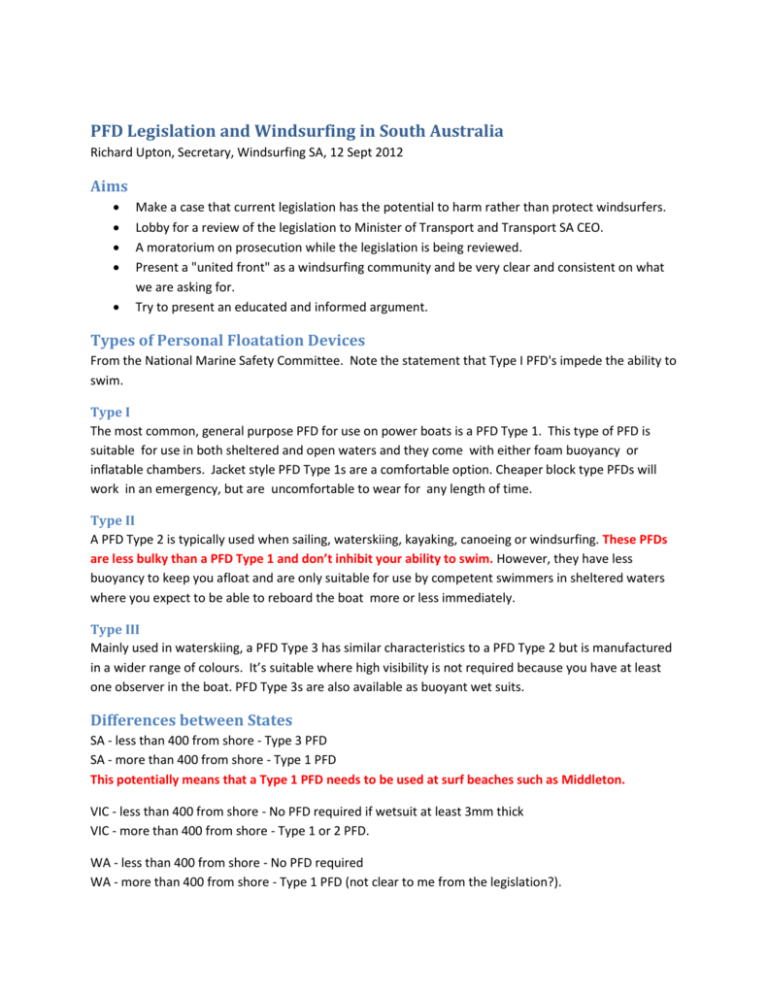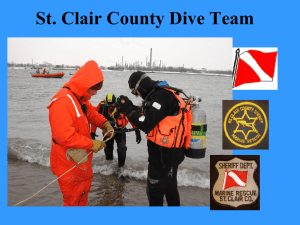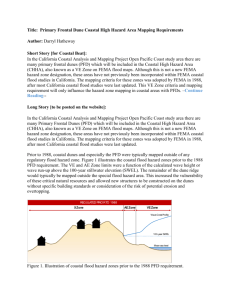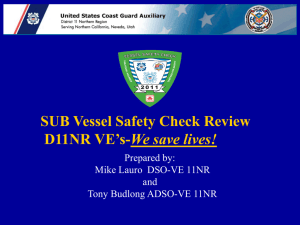PFD Legislation and Windsurfing in South Australia
advertisement

PFD Legislation and Windsurfing in South Australia Richard Upton, Secretary, Windsurfing SA, 12 Sept 2012 Aims Make a case that current legislation has the potential to harm rather than protect windsurfers. Lobby for a review of the legislation to Minister of Transport and Transport SA CEO. A moratorium on prosecution while the legislation is being reviewed. Present a "united front" as a windsurfing community and be very clear and consistent on what we are asking for. Try to present an educated and informed argument. Types of Personal Floatation Devices From the National Marine Safety Committee. Note the statement that Type I PFD's impede the ability to swim. Type I The most common, general purpose PFD for use on power boats is a PFD Type 1. This type of PFD is suitable for use in both sheltered and open waters and they come with either foam buoyancy or inflatable chambers. Jacket style PFD Type 1s are a comfortable option. Cheaper block type PFDs will work in an emergency, but are uncomfortable to wear for any length of time. Type II A PFD Type 2 is typically used when sailing, waterskiing, kayaking, canoeing or windsurfing. These PFDs are less bulky than a PFD Type 1 and don’t inhibit your ability to swim. However, they have less buoyancy to keep you afloat and are only suitable for use by competent swimmers in sheltered waters where you expect to be able to reboard the boat more or less immediately. Type III Mainly used in waterskiing, a PFD Type 3 has similar characteristics to a PFD Type 2 but is manufactured in a wider range of colours. It’s suitable where high visibility is not required because you have at least one observer in the boat. PFD Type 3s are also available as buoyant wet suits. Differences between States SA - less than 400 from shore - Type 3 PFD SA - more than 400 from shore - Type 1 PFD This potentially means that a Type 1 PFD needs to be used at surf beaches such as Middleton. VIC - less than 400 from shore - No PFD required if wetsuit at least 3mm thick VIC - more than 400 from shore - Type 1 or 2 PFD. WA - less than 400 from shore - No PFD required WA - more than 400 from shore - Type 1 PFD (not clear to me from the legislation?). NSW - less than 400 from shore - No PFD required NSW - more than 400 from shore - Type 2 PFD. All states above do not require a PFD to be worn for a surfboard, surf ski or racing shell. See Appendix 1, 2 & 3 for details for each state. Current practice Windsurfing is a diverse sport that can take place in a variety of wind and water conditions. At its gentlest in light winds and flat water, it has a very low risk of harm and the risks are analogous to standup paddleboards and surfskis in the same conditions (PFD's are not needed for these craft). At its most extreme in strong winds and large waves, windsurfers can be seen sailing without major incident in conditions that are not navigable for other craft. The principles for safe windsurfing in all conditions are widely understood by the windsurfing community: 1. They do not go out in conditions that pose a risk given their ability level, current fitness and equipment. 2. They do not sail further out from shore than they are prepared to paddle or swim in. 3. Self-rescue involves retrieving the board, and while using the board for floatation swimming the board and sail in to shore. This has been done many times by many windsurfers. In extreme conditions, the sailing rig is abandoned. At worst, the board and sailing rig is abandoned and the windsurfer will swim ashore. This then analogous in risk to a surf or ocean swim. 4. In a surf break, normal surf survival skills are needed. a. The ability to duck dive on coming waves b. The ability to duck dive equipment (yours or someone elses) carried towards you on a wave c. The ability to "unhook "the harness connecting you to the board and then swim out from under equipment d. The ability to breath hold and avoid injury while being "tumbled" by a breaking wave 5. Many windsurfers consider that their wetsuit provides the amount of added buoyancy that maximises their safety. Some consider a helmet rather than a PFD as the safety aid of choice. Sources of buoyancy available to a windsurfer The board is by far the greatest source of buoyancy. Board (70+ Litres of buoyancy) Wetsuit (5 L buoyancy) PFD (5-10 L buoyancy) The case for and against PFD's Advantages of sufficient personal buoyancy Will help support a tired conscious sailor if separated from the board Dangers of excessive personal buoyancy Impeded ability to swim and retrieve board (loss of major source of buoyancy) Impeded ability to swim ashore (greater chance of tiring and drowning) Impeded ability to duck dive waves (increased chance of injury or drowning in breaking water) Impeded ability to duck dive equipment (increased chance of injury or unconsciousness) Impeded ability to swim out from under equipment (increased chance of drowning) Dangers of a poorly designed PFD Impeded ability to unhook the harness line from the rig (danger of being trapped under the sail) Impediments of a PFD to sporting competition Loss of mobility due to a PFD impedes the practice of freestyle and wavesailing disciplines of windsurfing where sailors compete by performing complex, athletic maneuvers that are scored for style (as per gymnastics and surfing). Serious and Fatal Incidents involving Windsurfers There were no incidents in SA were the incident would have been preventable or lessened in severity by wearing a PFD. In South Australia http://www.courts.sa.gov.au/courts/coroner/index.html Death - Hardwicke Bay, Shark attack My recollection only: Death - Milang, Heart attack Long term Spinal Injury - Milang, Catapult in shallow water Broken leg and prolonged drifting - Seacliff Outside South Australia There are incidents outside SA were the incident may have have been preventable or lessened in severity by not wearing a PFD (*). Death* - Geraldton, Trapped under sail in surf Death* - France, Trapped under sail in shorebreak Death - Yamba, Heart attack Death - Philip Island, Shark attack Proposed rules that maximize the safety of windsurfers for comment Adopt current VIC legislation Within 400 m of shore -No PFD if wetsuit is at least 3mm thick. More than 400 m off shore - Type 1 or 2 PFD that does not impede swimming or harness use. Appendix 1 - Current SA legislation Division 4—Rules of special application to recreational vessels 169—Personal flotation devices to be worn on certain recreational vessels (1) Each occupant of— (a) a vessel (other than a surfboard, surf ski or racing shell) that can only carry the operator and no other person; or (b) a surfboard, surf ski or similar vessel that is being operated in inland waters; or (c) a sailboard or kiteboard; or must, at all times while the vessel is underway, wear— (j) in the case of a sailboard or kiteboard— (i) being operated more than 400 m from the shore— (A) before 1 June 2010—a PFD Type 1, PFD Type 2 or PFD Type 3; (B) on or after 1 June 2010—a PFD Type 1; or (ii) being operated not more than 400 m from the shore—a PFD Type 1, PFD Type 2 or PFD Type 3; Maximum penalty: $1 250. Expiation fee: $160. Appendix2 - Current VIC legislation Appendix3 - Current WA legislation Part VI — Private pleasure boats 46. Terms used (1) Subject to the provisions of regulation 3(2), a reference in this Part to a motor boat is a reference to a motor boat that is a pleasure vessel within the meaning of section 98(1) of the Western Australian Marine Act 1982; and the word owner has the meaning provided by that section. (2) In this Part — Level 50 means a personal flotation device classified as such by the Australian Standard AS 4758; Level 50S (Special) means a personal flotation device classified as such by the Australian Standard AS 4758; Level 100 means a personal flotation device classified as such by the Australian Standard AS 4758; Level 150 means a personal flotation device classified as such by the Australian Standard AS 4758; Level 275 means a personal flotation device classified as such by the Australian Standard AS 4758; pleasure vessel means —(a) a vessel held wholly for the purpose of recreational or sporting activities and not for hire or reward; and (b) any other vessel declared to be a vessel to which this Part applies by order of the Minister under subsection (2). (2) For the purposes of this Part — (a) a Level 100, a Level 150, a Level 275 and a SOLAS jacket all have a buoyancy equivalent to or higher than a PFD Type 1; and (b) a Level 50, a Level 100, a Level 150, a Level 275 and a SOLAS jacket all have a buoyancy equivalent to or higher than a PFD Type 2; and (c) a Level 50S, a Level 100, a Level 150, a Level 275 and a SOLAS jacket all have a buoyancy equivalent to or higher than a PFD Type 3; and (d) a PFD Type 3 has a buoyancy equivalent to a PFD Type 2. 51D. Certain vessels to be equipped with bilge pumps (3) The owner of a vessel of under 7 m length which is not fitted with a bilge pump must ensure that the vessel carries a bucket or bailer. 52A. Vessels to be equipped with personal flotation devices or life jackets (1) The owner of a vessel must ensure that the vessel, while being navigated outside protected waters, is equipped with — (a) a PFD Type 1; or (b) a life jacket that has been approved by the Australian Maritime Safety Authority established under section 5 of the Australian Maritime Safety Authority Act 1990 of the Commonwealth, for each person on board who has reached 12 months of age, appropriate in terms of the buoyancy and size to the body mass of every such person. (2) Subregulation (1) does not apply to — (a) a personal watercraft; or (b) a sailboard, being used within 400 m of any shore.(3) An owner who contravenes this regulation commits an offence. 52B. Vessels to be equipped with certain distress signals(1) The owner of a vessel must ensure that the vessel, while being navigated outside protected waters, is equipped with the following distress signals — (a) not less than — (i) 2 red hand held flares; or (ii) 2 parachute distress rockets; and (b) not less than — (i) 2 hand held orange smoke signals; or (ii) one orange smoke canister. (2a) Subregulations (1) and (2) do not apply to — (a) a personal watercraft; or (b) a sailboard, being used within 400 m of any shore. 52C. Vessels to be equipped with efficient anchor and lines(1) The owner of a vessel must ensure that the vessel, while being navigated outside protected waters, is equipped with an efficient anchor and line. (2) Subregulation (1) does not apply to a personal watercraft or a sailboard. navigable waters means — (a) the territorial sea adjacent to the State; and (b) the sea on the landward side of the territorial sea adjacent to the State that is not within the limits of the State; and (c) waters within the limits of the State on which any vessel or any type of marine craft can be navigated; protected waters means the waters contained in any lake, river or estuary, or by any breakwater, but does not include the waters of Cambridge Gulf or Lake Argyle; Appendix4 - Current NSW legislation





